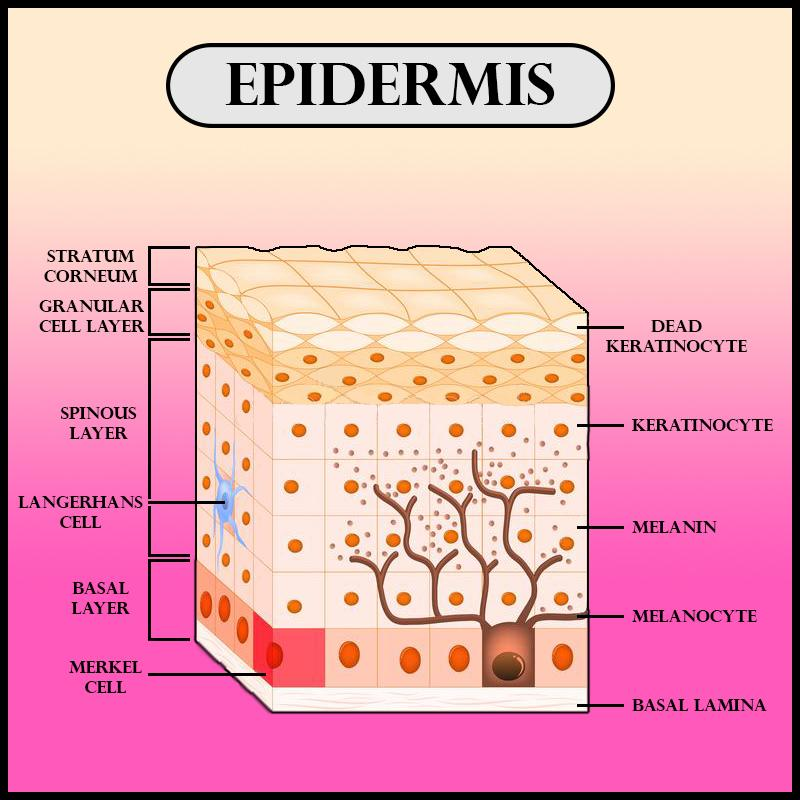
The outer layer of skin is called
(a)Dermis
(b)Epidermis
(c)Plasma
(d)Cortex
Answer
489.9k+ views
Hint: The outer layer of the skin is made up of cells that are flat in shape, called squamous cells and the layer provides a waterproof barrier to the body. It also protects the body from infection by various pathogens.
Complete answer:
The epidermis is known as the outermost layer of the skin. There are two layers of the epidermis, the living basal layer, that is next to the dermis, and the external stratum corneum, or horny layer, which is composed of dead, keratin-filled cells. The Basal (at the bottom of the epidermis) cells are present under the squamous cells.

Additional Information: -The epidermis has no blood supply and depends on diffusion from the dermal cells for all its metabolic needs.
-The dead-cell layer of the stratum corneum protects from a water loss that allows the vertebrates to dwell on land.
- Keratin, produced in migrating epidermal cells, forms the basis of nails in our fingers, feathers, and beaks of birds and other epidermal derivatives.
-The epidermis is thickest on the friction surfaces and thinnest over the eyelids, on the lower parts of the abdomen, and around the external genitalia.
-The epidermis consists of a living malpighian layer, in contact with the basement membrane (which is attached to the dermis), and a superficial horny layer of dead cells. The malpighian layer consists of both the stratum basale and the stratum spinosum of the epidermis layer.
So, the correct answer is, ‘Epidermis.’
Note: The epidermal cells, which multiply chiefly at the base in contact with the dermis, gradually ascend to the surface, manufacturing keratin as they go and finally die in the upper part, forming a horny layer.
Complete answer:
The epidermis is known as the outermost layer of the skin. There are two layers of the epidermis, the living basal layer, that is next to the dermis, and the external stratum corneum, or horny layer, which is composed of dead, keratin-filled cells. The Basal (at the bottom of the epidermis) cells are present under the squamous cells.

Additional Information: -The epidermis has no blood supply and depends on diffusion from the dermal cells for all its metabolic needs.
-The dead-cell layer of the stratum corneum protects from a water loss that allows the vertebrates to dwell on land.
- Keratin, produced in migrating epidermal cells, forms the basis of nails in our fingers, feathers, and beaks of birds and other epidermal derivatives.
-The epidermis is thickest on the friction surfaces and thinnest over the eyelids, on the lower parts of the abdomen, and around the external genitalia.
-The epidermis consists of a living malpighian layer, in contact with the basement membrane (which is attached to the dermis), and a superficial horny layer of dead cells. The malpighian layer consists of both the stratum basale and the stratum spinosum of the epidermis layer.
So, the correct answer is, ‘Epidermis.’
Note: The epidermal cells, which multiply chiefly at the base in contact with the dermis, gradually ascend to the surface, manufacturing keratin as they go and finally die in the upper part, forming a horny layer.
Recently Updated Pages
Master Class 11 Economics: Engaging Questions & Answers for Success

Master Class 11 Business Studies: Engaging Questions & Answers for Success

Master Class 11 Accountancy: Engaging Questions & Answers for Success

Master Class 11 English: Engaging Questions & Answers for Success

Master Class 11 Computer Science: Engaging Questions & Answers for Success

Master Class 11 Maths: Engaging Questions & Answers for Success

Trending doubts
Why was the Vernacular Press Act passed by British class 11 social science CBSE

Name the nuclear plant located in Uttar Pradesh class 11 social science CBSE

What steps did the French revolutionaries take to create class 11 social science CBSE

One Metric ton is equal to kg A 10000 B 1000 C 100 class 11 physics CBSE

How did silk routes link the world Explain with three class 11 social science CBSE

Difference Between Prokaryotic Cells and Eukaryotic Cells




